Our experience in harvesting, testing and storage of hematopoietic cord blood cells
- Authors: Abdulkadyrov K.M.1, Romanenko N.A.1, Selivanov E.A.1
-
Affiliations:
- Federal State University Russian Research Institute of Hematology and Transfusiology of the Ministry of Health and Social Development
- Issue: No 1 (2006)
- Pages: 63-65
- Section: Original Study Articles
- URL: https://genescells.ru/2313-1829/article/view/126317
- DOI: https://doi.org/10.23868/gc126317
- ID: 126317
Cite item
Abstract
The last two decades in biology and medicine have been marked by an increased interest in the study of human stem cells: their cultivation in vitro, determination of their ability to divide and specialize, application in clinical medicine for the treatment of certain fatal diseases, such as solid tumors, acute and chronic leukemia, aplastic anemia, hereditary metabolic disorders and the immune system, autoimmune diseases, diabetes mellitus, strokes, spinal cord injuries, myocardial pathology and others. The source of stem cells can be bone marrow, stimulated peripheral hematopoietic cells, adipose tissue, epithelial cells of the nasopharyngeal mucosa in the "olfactory epithelium", placental [umbilical] blood, placenta. Obtaining stem cells from the first four sources is somewhat difficult due to the need for surgical intervention and the use of anesthesia. Umbilical cord blood [PC] is collected without risk to the newborn and his mother. Therefore, in the article we want to dwell in detail on one of the stages of preclinical use of placental blood, share our experience in harvesting, laboratory testing and storage of stem cells.
Keywords
Full Text
About the authors
K. M. Abdulkadyrov
Federal State University Russian Research Institute of Hematology and Transfusiology of the Ministry of Health and Social Development
Author for correspondence.
Email: redaktor@celltranspl.ru
Russian Federation, Saint-Petersburg
N. A. Romanenko
Federal State University Russian Research Institute of Hematology and Transfusiology of the Ministry of Health and Social Development
Email: redaktor@celltranspl.ru
Russian Federation, Saint-Petersburg
E. A. Selivanov
Federal State University Russian Research Institute of Hematology and Transfusiology of the Ministry of Health and Social Development
Email: redaktor@celltranspl.ru
Russian Federation, Saint-Petersburg
References
- Абдулкадыров К.М., Романенко Н.А., Старков Н.Н. Получение и клиническое применение периферических гемопоэтических стволовых клеток из пуповинной крови. Вопросы онкологии 2000; 46[5): 513-20.
- Donaldson С., Armitage W.J., Denning-Kendall РА. Optimal cryopreservation of human umbilical cord blood. Bone Marrow Transplant. 1996; 18[4): 725-31.
- Richter E., Eichler H., Raske D. et al. 5% Me2S0 is sufficient to preserve stem cells derived from cord blood. Bone Marrow Transplant. 1998; 22[Suppl. 1): S16.
- Perutelli P„ Catellani S., Scarso L. et al. Processing of human cord blood by three different procedures for red blood cell depletion and mononuclear cell recovery. Vox. Sang. 1999; 76[4): 237-40.
- Абдулкадыров K.M., Романенко H.A. Заготовка и лабораторное тестирование гемопоэтических клеток пуповинной крови. Трансфузиология 2003; 4(1): 25-33.
- Guide to the preparation, use and quality assurance of blood components/2001/ 7th edition: 232.
Supplementary files










